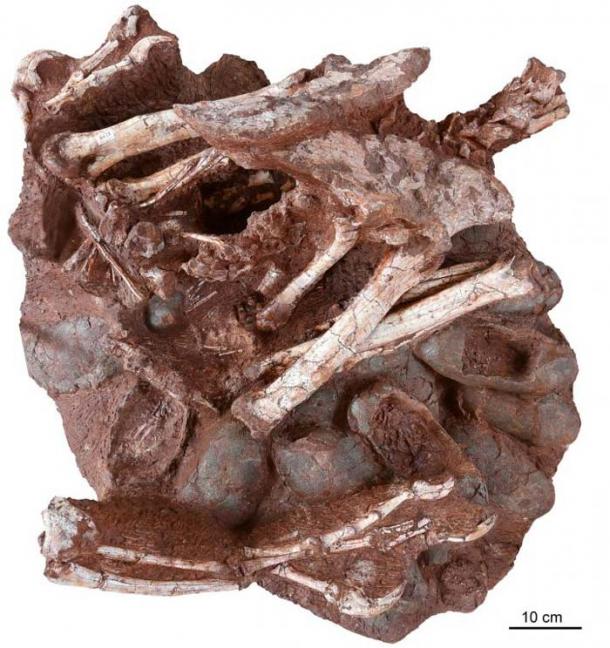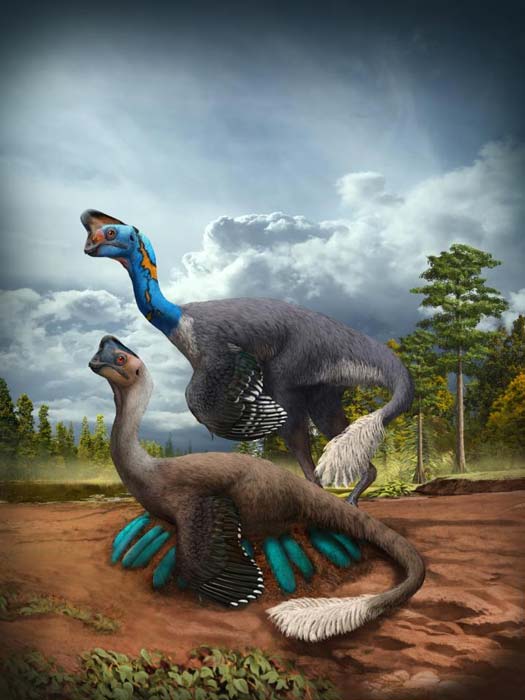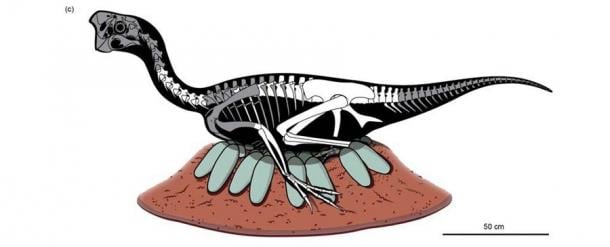Science
World First: Dinosaur Found on Fossilized Eggs with Babies Inside! – Ancient Origins

Scientists have made a major discovery in Ganzhou City in China’s southern Jiangxi Province. They’ve found the remains of a dinosaur sitting on its nest of fossilized eggs.
The dinosaur, an oviraptorosaur (oviraptor), belongs to a group of bird-like theropod dinosaurs which peaked during the distant Cretaceous Period (145 to 66 million years ago). The fossils of the adult oviraptor and the eggs with the embryos have been dated to roughly 70 million years old. This is the first time researchers have found a non-avian dinosaur sitting on a nest of eggs which have been fossilized so they still contain the babies inside!
The ~70-million-year-old fossil in question: an adult oviraptorid theropod dinosaur sitting atop a nest of its fossilized eggs. Multiple eggs (including at least three that contain embryos) are clearly visible, as are the forearms, pelvis, hind limbs, and partial tail of the adult. ( Shundong Bi, Indiana University of Pennsylvania )
What Do the Scientists Say About the Discovery?
Dr. Shundong Bi, of the Centre for Vertebrate Evolutionary Biology, Institute of Palaeontology, Yunnan University, China, Department of Biology, Indiana University of Pennsylvania, USA, and lead author of the study, told EurekAlert!, “Dinosaurs preserved on their nests are rare, and so are fossil embryos. This is the first time a non-avian dinosaur has been found, sitting on a nest of eggs that preserve embryos, in a single spectacular specimen.”
Although there are a few other examples of adult oviraptor found on their nests with eggs, this is the first time that scientists have found embryos inside the eggs. Study co-author Dr. Lamanna, a paleontologist from the Carnegie Museum of Natural History, USA, explains: “This kind of discovery, in essence fossilized behavior, is the rarest of the rare in dinosaurs. Though a few adult oviraptorids have been found on nests of their eggs before, no embryos have ever been found inside those eggs.”
[embedded content]
Dr. Xu, from the Institute of Vertebrate Paleontology and Paleoanthropology in Beijing, China, and one of the authors of the study, expects that this rare discovery holds a great deal of information, “It’s extraordinary to think how much biological information is captured in just this single fossil.” Dr. Xu says, “We’re going to be learning from this specimen for many years to come.”


An attentive oviraptorid theropod dinosaur broods its nest of blue-green eggs while its mate looks on in what is now Jiangxi Province of southern China some 70 million years ago. ( Zhao Chuang )
The Fossilized Eggs were about to Hatch!
The scientists found an incomplete skeleton of an adult oviraptor with pebbles in its stomach. This is an example of gastroliths, “stomach stones,” which the creature had consumed to help it digest its food. It’s also the first example of undisputed gastroliths found in an oviraptorid, which the team believes could help provide new information about the diet of these dinosaurs.
The dinosaur was found crouched over the nest of at least 24 fossilized eggs, in a brooding or protective posture. This suggests the dinosaur died while brooding or protecting its babies. But when the researchers used oxygen isotope analysis on the eggs they found that they had been incubated at high, bird-like temperatures, which support the belief that the adult more likely died while brooding its nest.


The partial skeleton of the oviraptorosaur was found on a nest of at least 24 fossilized eggs. ( Bi et al., Science Bulletin, 2020 )
At least seven of the fossilized eggs still contain the remains of unhatched oviraptorid embryos. Based on the development of the embryos, the scientists think that some of the eggs were on the verge of hatching. According to Dr. Lamanna, “This dinosaur was a caring parent that ultimately gave its life while nurturing its young.”
The article is published in Science Bulletin .
Top Image: Representational image of a baby dinosaur in an egg. Source: KtD / Adobe Stock
By Alicia McDermott
Science
Giant prehistoric salmon had tusk-like teeth for defence, building nests


|
|
The artwork and publicity materials showcasing a giant salmon that lived five million years ago were ready to go to promote a new exhibit, when the discovery of two fossilized skulls immediately changed what researchers knew about the fish.
Initial fossil discoveries of the 2.7-metre-long salmon in Oregon in the 1970s were incomplete and had led researchers to mistakenly suggest the fish had fang-like teeth.
It was dubbed the “sabre-toothed salmon” and became a kind of mascot for the Museum of Natural and Cultural History at the University of Oregon, says researcher Edward Davis.
But then came discovery of two skulls in 2014.
Davis, a member of the team that found the skulls, says it wasn’t until they got back to the lab that he realized the significance of the discovery that has led to the renaming of the fish in a new, peer-reviewed study.
“There were these two skulls staring at me with sideways teeth,” says Davis, an associate professor in the department of earth sciences at the university.
In that position, the tusk-like teeth could not have been used for biting, he says.
“That was definitely a surprising moment,” says Davis, who serves as director of the Condon Fossil Collection at the university’s Museum of Natural and Cultural History.
“I realized that all of the artwork and all of the publicity materials and bumper stickers and buttons and T-shirts we had just made two months prior, for the new exhibit, were all out of date,” he says with a laugh.
Davis is co-author of the new study in the journal PLOS One, which renames the giant fish the “spike-toothed salmon.”
It says the salmon used the tusk-like spikes for building nests to spawn, and as defence mechanisms against predators and other salmon.
The salmon lived about five million years ago at a time when Earth was transitioning from warmer to relatively cooler conditions, Davis says.
It’s hard to know exactly why the relatives of today’s sockeye went extinct, but Davis says the cooler conditions would have affected the productivity of the Pacific Ocean and the amount of rain feeding rivers that served as their spawning areas.
Another co-author, Brian Sidlauskas, says a fish the size of the spike-toothed salmon must have been targeted by predators such as killer whales or sharks.
“I like to think … it’s almost like a sledgehammer, these salmon swinging their head back and forth in order to fend off things that might want to feast on them,” he says.
Sidlauskas says analysis by the lead author of the paper, Kerin Claeson, found both male and female salmon had the “multi-functional” spike-tooth feature.
“That’s part of our reason for hypothesizing that this tooth is multi-functional … It could easily be for digging out nests,” he says.
“Think about how big the (nest) would have to be for an animal of this size, and then carving it out in what’s probably pretty shallow water; and so having an extra digging tool attached to your head could be really useful.”
Sidlauskas says the giant salmon help researchers understand the boundaries of what’s possible with the evolution of salmon, but they also capture the human imagination and a sense of wonder about what’s possible on Earth.
“I think it helps us value a little more what we do still have, or I hope that it does. That animal is no longer with us, but it is a product of the same biosphere that sustains us.”
This report by The Canadian Press was first published April 24, 2024.
Brenna Owen, The Canadian Press





Science
Giant prehistoric salmon had tusk-like spikes used for defence, building nests: study


|
|
A new paper says a giant salmon that lived five million years ago in the coastal waters of the Pacific Northwest used tusk-like spikes as defense mechanisms and for building nests to spawn.
The initial fossil discoveries of the 2.7-metre-long salmon in Oregon in the 1970s were incomplete and led researchers to suggest the fish had fang-like teeth.
The now-extinct fish was dubbed the “saber-tooth salmon,” but the study published in the peer-reviewed journal PLOS One today renames it the “spike-toothed salmon” and says both males and females possessed the “multifunctional” feature.
Study co-author Edward Davis says the revelation about the tusk-like teeth came after the discovery of fossilized skulls at a site in Oregon in 2014.
Davis, an associate professor in the department of earth sciences at the University of Oregon, says he was surprised to see the skulls had “sideways teeth.”
Contrary to the belief since the 1970s, he says the teeth couldn’t have been used for any kind of biting.
“That was definitely a surprising moment,” Davis says of the fossil discovery in 2014. “I realized that all of the artwork and all of the publicity materials … we had just made two months prior, for the new exhibit, were all out of date.”





Science
SpaceX sends 23 Starlink satellites into low-Earth orbit


|
|
April 23 (UPI) — SpaceX launched 23 Starlink satellites into low-Earth orbit Tuesday evening from Space Launch Complex 40 at Cape Canaveral Space Force Station in Florida.
Liftoff occurred at 6:17 EDT with a SpaceX Falcon 9 rocket sending the payload of 23 Starlink satellites into orbit.
The Falcon 9 rocket’s first-stage booster landed on an autonomous drone ship in the Atlantic Ocean after separating from the rocket’s second stage and its payload.
The entire mission was scheduled to take about an hour and 5 minutes to complete from launch to satellite deployment.
The mission was the ninth flight for the first-stage booster that previously completed five Starlink satellite-deployment missions and three other missions.





-



 Health21 hours ago
Health21 hours agoRemnants of bird flu virus found in pasteurized milk, FDA says
-
Art21 hours ago
Random: We’re In Awe of Metaphor: ReFantazio’s Box Art
-
News17 hours ago
Amid concerns over ‘collateral damage’ Trudeau, Freeland defend capital gains tax change
-
Art15 hours ago
The unmissable events taking place during London’s Digital Art Week
-
Tech22 hours ago
Surprise Apple Event Hints at First New iPads in Years
-
Media20 hours ago
Vaughn Palmer: B.C. premier gives social media giants another chance
-
Science20 hours ago
NASA hears from Voyager 1, the most distant spacecraft from Earth, after months of quiet
-



 Politics19 hours ago
Politics19 hours agoHow Michael Cohen and Trump went from friends to foes





